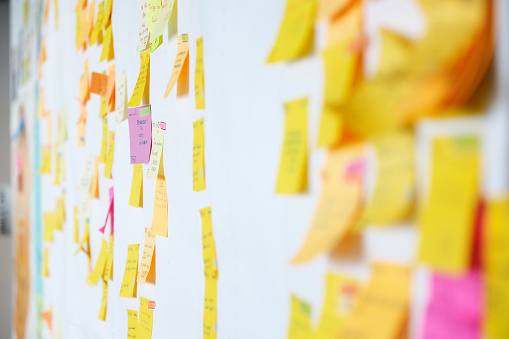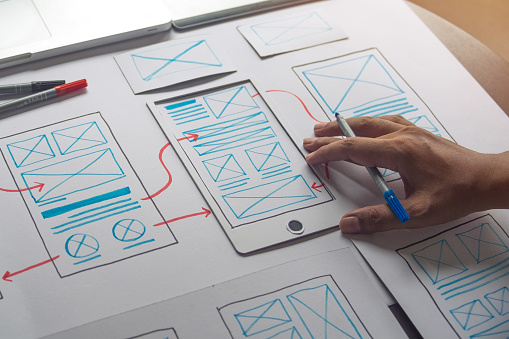Design Thinking 101: What Is Design Thinking?
Q: How many designers does it take to change a light bulb?
A: Why a light bulb?
From the first horseless carriage to the sleekest smartphones, brilliant designs present a paradox: we take our new tools for granted, even as they transform our lives. That’s because successful design is—unsurprisingly—human-centered design. The great inventors didn’t think that they were creating a product (even though they were).
They thought they were helping people.
Which is why they didn’t get stuck on finding ways to improve simple phones, or to make horses pull carriages faster.
They saw the real problems people struggle with daily:
- Not being able to get the information they need, when & where they need it
- Not being able to travel quickly & independently.
And so the car, and the smartphone on which you’re probably reading this, were born.
But this idea of finding the REAL problem, and experimenting to solve it, isn’t just for earth-shattering inventions. It’s for all designers.
Because whenever you’re creating or improving anything—a chair, a medical software program, a lead-converting website—you’re doing it to make life easier for your users.
That’s why great design is hardly noticed (when was the last time you actually thought about the design of your favorite app?). It’s the ultimate exercise in humility: your design’s very efficiency & usefulness makes people focus on the actual product & service, not the intuitive way they interact with it.
So how to create such quietly successful designs?
The process has a simple name: Design Thinking.
And the basics are pretty simple too.
So we’re going to give you a quick-and-dirty Crash Course in Design Thinking. Whatever industry you’re in, you’ll soon be able to boost your team’s creativity & efficiency with these 5 principles (don’t worry, we’ll go into a LOT more detail on them in later posts!)
The 5 Steps of Design Thinking
Step 1: Empathize
WHAT:
Listen to your users! Understand how and why they do things they way they do. Dig into their deeper needs and find out what’s really important to them, in context of your project.
WHY:
Because you’re being paid to solve their problems, so it’s good to know what those problems are first. 🙂
HOW:
Two main ways (preferably carried out at the same time)
- Observe (Watch them using your product or service)
- Engage (Listen to their walkthroughs and explanations of why they’re doing it that way)


Step 1: Empathize
WHAT:
Listen to your users! Understand how and why they do things they way they do. Dig into their deeper needs and find out what’s really important to them, in context of your project.
WHY:
Because you’re being paid to solve their problems, so it’s good to know what those problems are first. 🙂
HOW:
Two main ways (preferably carried out at the same time)
- Observe (Watch them using your product or service)
- Engage (Listen to their walkthroughs and explanations of why they’re doing it that way)
Step 2: Define
WHAT:
Find the right question to ask.
WHY:
Not properly defining the assignment results in a mediocre, lackluster design. For instance, early car magnate Henry Ford said that, if you asked what travellers wanted in 1870, they would’ve asked for faster horses…but that’s not what they really needed.
That’s why the big results come from designers who, having listened to their users, find and articulate the real problems.
HOW:
Discover connections and patterns, things that stood out when you were listening to the users in Step 1.


Step 2: Define
WHAT:
Find the right question to ask.
WHY:
Not properly defining the assignment results in a mediocre, lacklustre design. For instance, early car magnate Henry Ford said that, if you asked what travellers wanted in 1870, they would’ve asked for faster horses…but that’s not what they really needed.
That’s why the big results come from designers who, having listened to their users, find and articulate the real problems.
HOW:
Discover connections and patterns, things that stood out when you were listening to the users in Step 1.
Step 3: Ideate
WHAT:
Brainstorm. No bad ideas here…throw it all on the table!
WHY:
This is where your team begins to find the solution…but worrying about getting the “right” answer right away stifles the creative juices. Instead, encourage your team to go beyond obvious answers so that you have many options to choose from, vote on, & combine.
HOW:
Lots of ways, some including Legos…there’ll be a whole post about this further in our Design Thinking series! The main thing is to build on each others’ ideas within the constraints of the question defined in Step 2.


Step 3: Ideate
WHAT:
Brainstorm. No bad ideas here…throw it all on the table!
WHY:
This is where your team begins to find the solution…but worrying about getting the “right” answer right away stifles the creative juices. Instead, encourage your team to go beyond obvious answers so that you have many options to choose from, vote on, & combine.
HOW:
Lots of ways, some including Legos…there’ll be a whole post about this further in our Design Thinking series! The main thing is to build on each others’ ideas within the constraints of the question defined in Step 2.
Step 4: Prototype
WHAT:
Actually building things…lots of different things. Start with quick & cheap creations (think in terms of readily available office supplies), moving to more permanent & refined prototypes as the solution (or solutions) to your problem become clearer.
WHY:
Fail quickly and cheaply! In other words, testing a number of solutions (see Step 5) & combining the best parts of all (and testing those too, of course!) will result in a more comprehensive, effective final solution.
HOW:
Don’t get married to one idea…just have your team pick up materials, start creating.
Do control variables: with each prototype, ask what aspect of the solution is being tested, what behavior is expected of the users, and what feedback you got from the testers.


Step 4: Prototype
WHAT:
Actually building things…lots of different things. Start with quick & cheap creations (think in terms of readily available office supplies), moving to more permanent & refined prototypes as the solution (or solutions) to your problem become clearer.
WHY:
Fail quickly and cheaply! In other words, testing a number of solutions (see Step 5) & combining the best parts of all (and testing those too, of course!) will result in a more comprehensive, effective final solution.
HOW:
Don’t get married to one idea…just have your team pick up materials, start creating.
Do control variables: with each prototype, ask what aspect of the solution is being tested, what behavior is expected of the users, and what feedback you got from the testers.
Step 5: Test
WHAT:
Learn about your solution AND your user (see Step 1…a few cycles through 1-5 are often necessary and useful!) as they put your prototypes into practice.
WHY:
Refine your solution so it serves them better. This step also helps you circle back to Steps 1 and 2, because you’ll understand your user AND be able to define the problem even better until you arrive at the perfect solution.
HOW:
Show, don’t tell! Ideally, you’ll just present the prototype to your user, explaining it as little as possible (because, as aforesaid, it should be so intuitive they hardly have to think about it anyway.) Also ask users to compare prototypes so you can implement the best of both.


Step 5: Test
WHAT:
Learn about your solution AND your user (see Step 1…a few cycles through 1-5 are often necessary and useful!) as they put your prototypes into practice.
WHY:
Refine your solution so it serves them better. This step also helps you circle back to Steps 1 and 2, because you’ll understand your user AND be able to define the problem even better until you arrive at the perfect solution.
HOW:
Show, don’t tell! Ideally, you’ll just present the prototype to your user, explaining it as little as possible (because, as aforesaid, it should be so intuitive they hardly have to think about it anyway.) Also ask users to compare prototypes so you can implement the best of both.
Congrats…you’ve completed our intro to the 5 steps of Design Thinking!
As you can see, they’re not necessarily linear…you’ll probably define and redefine your question several times, listen a LOT to the users all the way through, and come up with more prototypes and tests based on that.
But it’s all worth it in the end, when your solution is so elegantly simple that people don’t even notice that it’s changed the way they do things…for the better.
__
Resources About Design Thinking
Interaction Design Foundation
IDEO | Design Thinking
Design Thinking TED Talk by Tim Brown